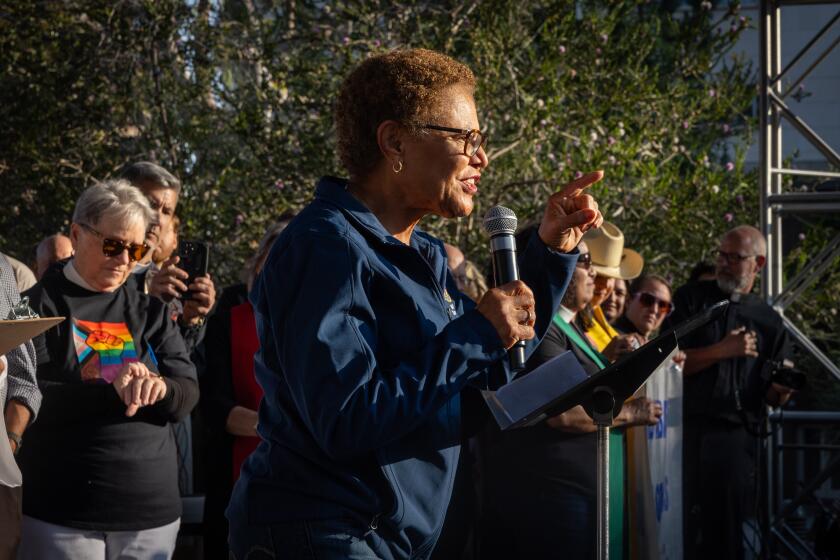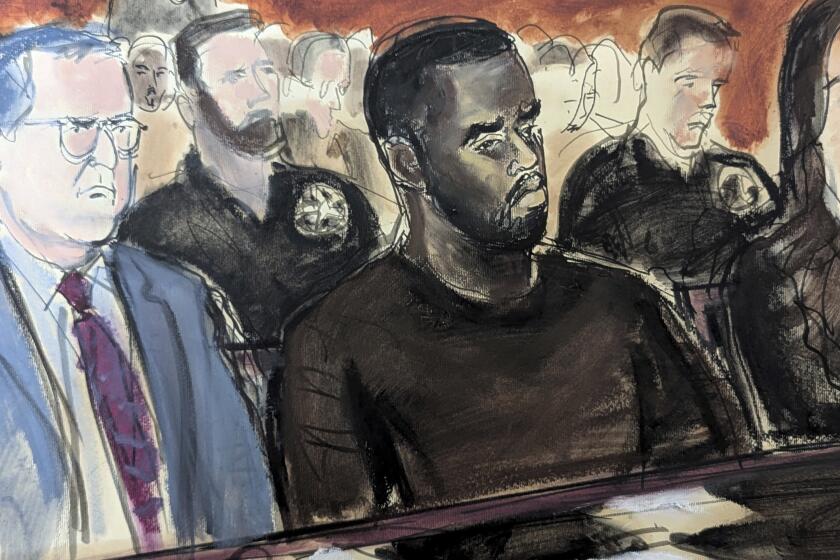Other Serial Slayings Tinged by Satanism : Elements of Devil Worship in Stalker Case May Not Be Factors in Motivation, Experts Caution
- Share via
Richard Ramirez, suspected by police in the 16 Night Stalker slayings, is the latest in a small group of American murder suspects whose crimes have been associated with satanism.
The revelation that spray-painted pentagrams--a distinctive satanist symbol--had been found on the walls of the homes of some of Ramirez’s alleged victims added an ominous edge to an already gruesome string of killings.
Bolstering the satanist connection was the discovery of a baseball cap, left at the scene of a Rosemead killing attributed to the stalker, that contained the logo of a popular heavy-metal rock group that has been accused of injecting devil-worshiping sentiments into its music.
Classmate’s Observation
A San Francisco newspaper quoted a former El Paso, Tex., classmate of Ramirez as saying that the suspect was obsessed with what he believed were satanic themes in the music of the band AC/DC. Ramirez was particularly attracted to the band’s 1979 hit album “Highway to Hell,” said Ray Garcia, 27, of El Sobrante, Calif. The album’s cover depicts a band member wearing devil’s horns, and one of the songs included is titled “Night Prowler.”
Several authorities familiar with serial murderers and cults cautioned Sunday, however, that it would be a mistake to draw conclusions about a murder suspect’s motivation on the basis of such evidence.
“Anybody who is going to serially murder a number of people is probably a little unusual, and what he develops an interest in isn’t going to automatically connect” with the slayings themselves, said Richard Ofshe, a sociologist at the University of California, Berkeley, who specializes in studying what he calls “thought reform and social control in extremist or fanatic organizations.”
James Alan Fox, a Northeastern University criminal justice professor and author of a recent book on mass murderers, said “a small but insignificant number of mass murderers” have invoked satanism to explain their crimes.
“But the one thing you really can’t figure out is to what extent it is used as an excuse,” Fox said. “Some people may actually have convinced themselves that these executions are necessary.
“I don’t know anybody who believes that Satan has anything to do with murder,” Fox said. If a killer claims the devil made him do it, “either he is faking or using it as an excuse or he is psychotic. And keep in mind that incidents of psychosis--people hearing voices, for example--are rare in all kinds of murder, particularly in serial murders. Most serial killers are sane. They don’t hear voices. They don’t have consciences, but that doesn’t mean they’re diseased.”
Probably the most celebrated recent case of a supposedly demon-driven killer was the “Son of Sam” case, in which David Berkowitz was convicted of murdering six people in New York.
After his arrest in 1977, Berkowitz claimed that “legions of Satan’s henchmen” had ordered him to shoot people in isolated areas of Brooklyn, Queens and the Bronx. Within a year, while awaiting sentencing, he was occasionally describing himself as a born-again Christian. And a year after that, he gave a prison interview in which he admitted making up the satanic influence.
The killings were “motiveless and senseless,” Berkowitz said, and his tales of taking death orders from demons or from a dog owned by his neighbor Sam Carr (hence the name “Son of Sam”) were “baloney.”
Too Early to Tell
A law enforcement source familiar with the details of the Night Stalker investigation said Sunday that it is too early to tell if the killings were associated with satanism.
Meyer Lightman, a Van Nuys social worker who has studied Satan worshipers and those involved in witchcraft, said he doubts that Ramirez was a member of an organized devil-worshiping cult.
“Usually you have pretty consistent ritual in anything to do with cults, and I don’t see any consistency” in the pattern of killings, rapes and other assaults that Ramirez is suspected of committing, Lightman said. “This guy just sounds to me like a . . . pathological person looking for glory and who got himself caught.”
Sociology professor Ofshe added, “It wouldn’t surprise me if the person who did this had some unusual notions about what they were doing and if that notion was something they created all by themselves, without any outside input,” possibly to justify the crimes after they began.
Modern satanism dates from an “occult revival” that took place in the 19th Century. It includes practices that in previous centuries had been attributed to witches and sorcerers and has attracted followers who range from theologians intrigued by the belief’s preaching of self-indulgence to sadomasochists who use it to justify sexual assaults, animal sacrifices and human bloodletting.
Anger, Frustration
Satanist worship has strong overtones of anger and frustration toward the Judeo-Christian God. A distinctive liberal “wing” is the Church of Satan, founded in San Francisco in 1966 by Anton Szandor LaVey, a former animal trainer and carnival organist. LaVey’s brand of satanism emphasizes gratification of man’s physical or mental nature and asserts that Satan represents dominant values in America. By the late 1970s, the church claimed 10,000 members.
Social worker Lightman said satanists are often people “extremely alienated” from society, people who have “enormous amounts of inner rage which could get channeled by a charismatic figure,” such as Charles Manson, whose followers were convicted of nine Southern California murders committed in the late 1960s.
(Ironically, as in the Night Stalker case, rock music was intertwined with the Manson killings. Manson used a Beatles song, “Helter Skelter,” as the title of his self-styled philosophy that saw gruesome killings as a way to provoke a racial holocaust that would see blacks emerge triumphant.)
Public awareness of satanism appears to have increased because of the persistent complaints by Christian groups and other organizations that the dark philosophy has been subtly introduced in many rock music lyrics and by allegations that satanism has been a factor in other highly publicized crimes. For example:
- Earlier this year, child witnesses in the McMartin Pre-School molestation case testified that they were forced to participate in satanistic rituals in which black-robed individuals chanted and killed animals on an altar. One of the Manhattan Beach preschool’s students said he was forced to drink blood. Defense attorneys have said that the children were making up the allegations.
- For the last year, a law enforcement task force has investigated allegations that as many as 75 adults have taken part in satanic child molestation rings in Bakersfield and have engaged in cannibalistic killings of infants. Children have told counselors stories of rituals involving swords, knives, robes and the dismemberment of animals. No remains of a body have been found, however, and no children supposedly slain by the cults have been reported missing.
- In Toledo, Ohio, Sheriff James Telb ordered remote fields and woods dug up in search of possible human remains three months ago after he received information from three “reasonably reliable sources” that a satanic cult of 200 people had presided over killings and mass burials. No bodies were found.
- And in a 1984 Long Island, N.Y., case, the drug-induced killing of a 17-year-old boy was initially attributed by police to part of a “satanic ritual” in which the boy was kicked, beaten and forced to declare his love for Satan before being killed. Six months later, however, both the prosecutor and defense lawyers said the killing simply grew out of a pervasive use of violence-inducing hallucinogens.
Such cases illustrate a major problem in evaluating the influence of satanism, sociology professor Ofshe said.
“There’s nothing--nothing I know of--pinned down,” he said. “There are so often stories suggesting that people have seen children killed in the midst of a satanic ritual--they’re all over the place--but somehow the bodies never get found.”
Contributing to this story were Times staff writers David Freed and Carol McGraw and Times research librarian Doug Conner.
More to Read
Sign up for Essential California
The most important California stories and recommendations in your inbox every morning.
You may occasionally receive promotional content from the Los Angeles Times.













